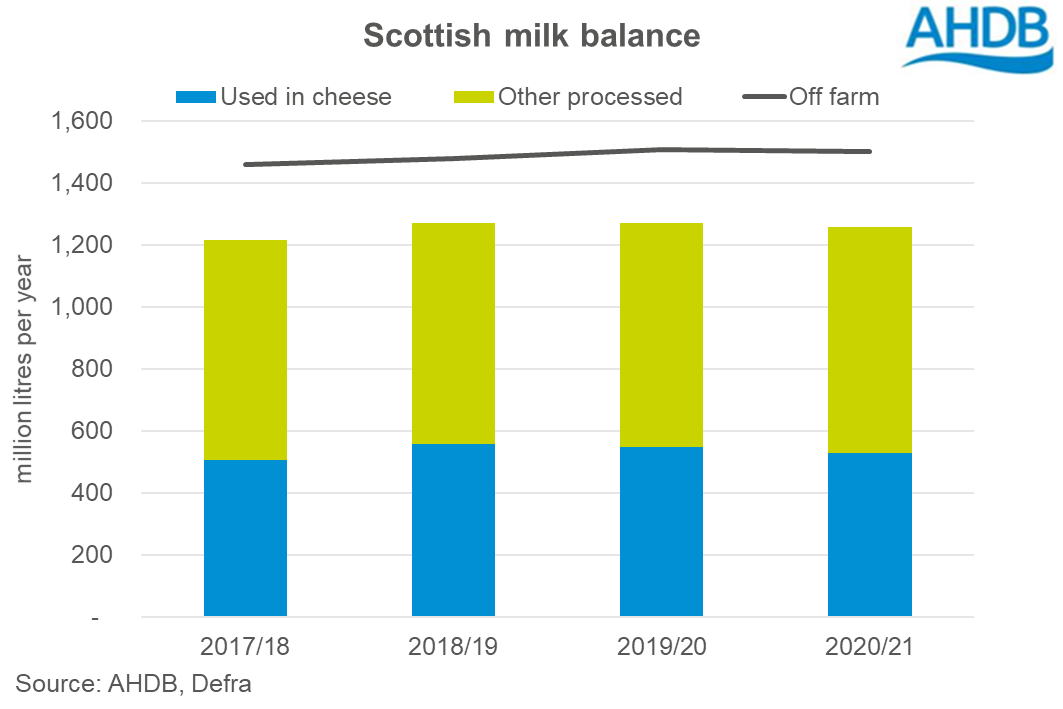Scottish milk balance
Tuesday, 18 May 2021
By Chris Gooderham
In 2020/21, it is estimated that Scottish farmers supplied 1.5 billion litres of milk. Of that milk, 84% was processed in Scotland and 16% was transported into England for processing. Of the volume processed in Scotland, around 530m litres was processed into cheese, and some 730m litres into other products, the majority of which was liquid milk.
Supply
Scotland milk production is estimated to have reduced by 0.4% between 2019/20 and 2020/21. The milking herd fell by 1.6%, which was partially offset by an estimated 1.2% lift in milk yields. The drop in volumes is the first in four years, following three consecutive rises. Since 2015, the Scottish herd size has fallen slightly, by 1.6%, while England's has fallen by 4.3% and Wales’ has increased by 2.4%.
Processing
Cheese production is estimated to have fallen slightly in 2020/21, mainly off the back of the closures of Campbeltown and Arran in 2019/20. That has been partly offset by increased throughput in other sites. Overall, the volume that was exported to England for processing was much unchanged on the year before at around 240m litres.

The future
Long-term trends in consumption and processing show an increase in the amount of milk used to make cheese and yogurt, and a reduction in the volume used for liquid milk. By 2030, we expect around a third of the milk coming off farm in the UK to end up in cheese. The proportion of Scottish milk currently ending up in Scottish cheese is already in line with these projections.
However, the overall volume of milk processed in Scotland has not changed much over the last 10 years. The number of processing sites has reduced, but the remaining facilities have grown larger. This means processing is now consolidated into some key regions.
Meanwhile, more milk is coming off farms. Since 2010/1, milk production in Scotland has increased by an estimated 18%, but processing has only risen by 4%.
There is a fine balance between the economies of scale achieved from fewer, but larger, processing facilities and the subsequent potential increase in milk haulage costs. Looking ahead, getting this balance right will be the key to supply chain profitability.

Sign up to receive the latest information from AHDB.
While AHDB seeks to ensure that the information contained on this webpage is accurate at the time of publication, no warranty is given in respect of the information and data provided. You are responsible for how you use the information. To the maximum extent permitted by law, AHDB accepts no liability for loss, damage or injury howsoever caused or suffered (including that caused by negligence) directly or indirectly in relation to the information or data provided in this publication.
All intellectual property rights in the information and data on this webpage belong to or are licensed by AHDB. You are authorised to use such information for your internal business purposes only and you must not provide this information to any other third parties, including further publication of the information, or for commercial gain in any way whatsoever without the prior written permission of AHDB for each third party disclosure, publication or commercial arrangement. For more information, please see our Terms of Use and Privacy Notice or contact the Director of Corporate Affairs at info@ahdb.org.uk © Agriculture and Horticulture Development Board. All rights reserved.

